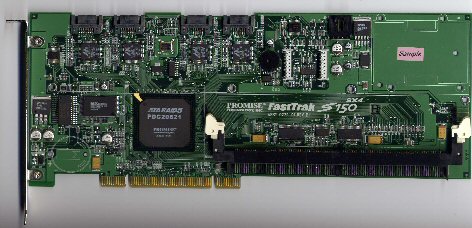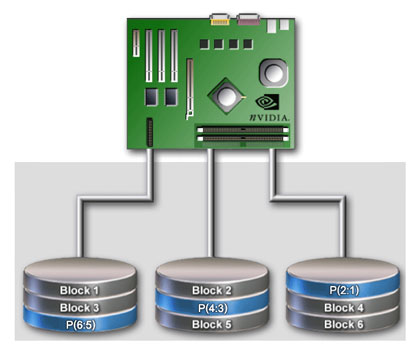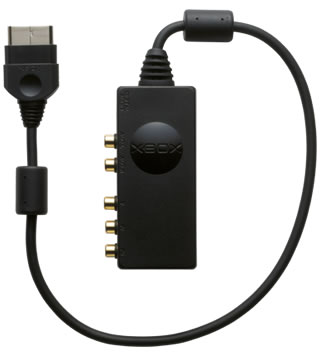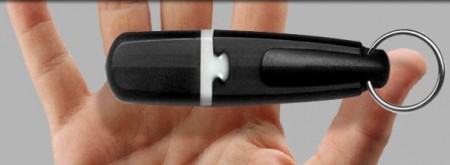FastTrak S150 SX4
- Four-port Serial ATA RAID controller with 1.5Gbps per channel
- 32-Bit/66MHz PCI 2.2 interface
- Support for RAID level 0, 1, 10, 5 and JBOD
- Online array expansion and RAID level migration to add capacity on the fly
- Supports hot swap of failed drives
- Automatic/manual rebuild of hot spare drive
- PerfectRAID technology for robust error handling and recovery of fatal, media and disk errors
- Variable stripe block size support enables optimization for diverse application requirements
- Supports up to 256MB of SDRAM memory
- Seamless upgrade to Promise’s external storage solutions
Promise controllers and I are old friends, all the way back to their first ATA RAID controller. Their latest is the Promise FastTrak S150 SX4: a four port Serial ATA RAID controller. Looking at the image, you’re probably thinking you’ve seen it somewhere before: the S150 SX4 shares the same PCB layout and size as the SX4000. The only differences are the SATA connectors and the Marvell PATA to SATA converter chips. For a complete rambling on the Marvell chip check out our 3ware Escalade 8506-8 review.
This time around I didn’t get a retail package for review, but a review’s package. What should come in the box is the controller, SATA cables, installation manual, and drivers and management software on 3.5” floppy disk and CD-ROM. In case you’re wondering the review’s package came with the controller, photocopied manual, burned CD, reviewer’s guide and 128 MB DIMM. You’re not missing out on anything, and it’s a good thing I already had SATA cables.
Looking at the S150 SX4 board layout, it’s a match to the SX4000. The same single Promise PDC20621 ASIC to handle XOR ( RAID 5 parity calculations ) and the four ATA channels. What’s been added to the S150 SX4 are four Marvell 88i8030-TBC parallel to serial ATA converter chips. As well and I2C connector is in the top left, for those motherboards that support it for system monitoring. The only mention of it in the user manual is in the board layout. A very large board that in it’s next version will be about half that size. It’s interesting that the four status lights from the SX4000 have been dropped: since they weren’t documented it’s left a mystery.
Installation was very simple. I configured an array via the S150 SX4’s BIOS, called FastBuild. Entering Windows 2000 I was prompted for drivers, then a reboot and installation of the PAM utility.
Feature wise Promise has everything there you’ll need. It’s a 32 bit 66 MHz PCI controller capable of bursting 266 MB per second. It handles four SATA drives in configurations of RAID 0, 1, 10, 5 and JBOD ( just a bunch of disks ). The manual and all configuration screens I encountered showed the S150 SX4 handling RAID 0+1 and not RAID 10, but the Promise website and it’s datasheet both list RAID 10. Check our RAID Types to see the difference. Promise calls it’s ability to recover from an error by drive hot swapping or hot replacing PerfectRAID, although all controllers support this. With Promise they would like you to use their Superswap 1100 enclosures. Cache is required for the controller to operate, and a user installed SDRAM DIMM of 64 – 256 MB must be installed. I found it funny that page 30 of the user manual shows an example of the BIOS configuration with a 512MB DIMM installed.
Management of the S150 SX4 is handled via the Promise Array Management, or PAM. This utility has been around for some time, but is updated for every generation of Promise cards. It’s very clean the menus follow a nice flow. IT has the usual features: array build, monitoring and SMART support, email and pager notification. It’s standout feature in my opinion is array expansion and conversion, covered on pages 67 -73 of the PAM user manual. This allows an array to be expanded by adding more disks, or converted to another RAID level. Some caveats of course, but it works and works well. I added a fourth disk to a RAID 5 array. It was time consuming but worthwhile. Once completed it’s best to use a partition management package to resize the partition and get the benefit of the extra space. This functionality screams out for a controller that can handle more than four drives: when will Promise match 3ware’s eight and twelve drive controllers?
Performance has been increased substantially to match the 3ware Escalade 8506, judging by our extensive benchmarks. While the previous Promise SX4000 trailed the 3ware Escalade 7500 across the board, now we see a neck and neck race. Promise pulls ahead of the competition in price: the FastTrak S150 SX4 can be found for almost half of the 3ware Escalade 8506-4, it’s direct competitor. Where it falls short is drive capacity and PCB size: let’s see some 12 port SATA controllers in a low profile PCI-X packaging. If four drives are all you need, the Promise FastTrak S150 SX4 is the SATA controller for you.
Editors note: this review was migrated from the old eBabble.net site and the photos updated. Originally published November 28th 2003.





